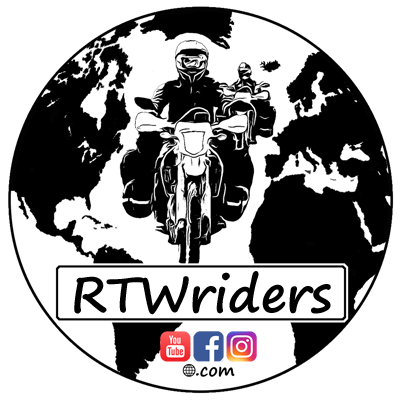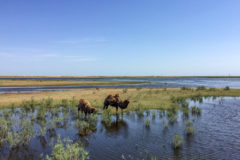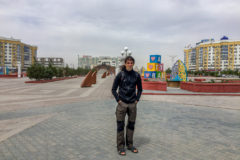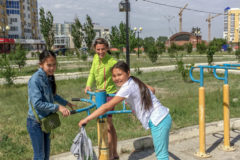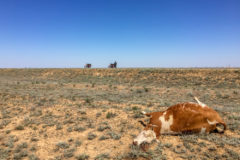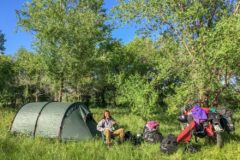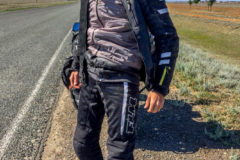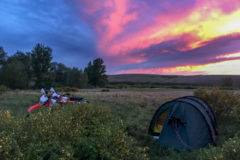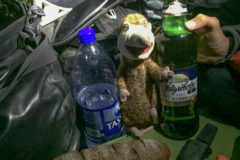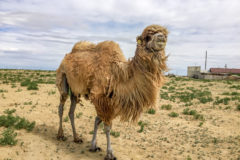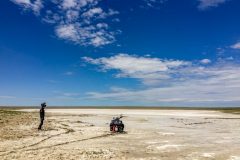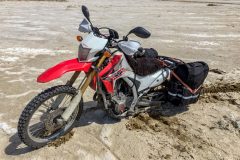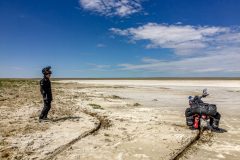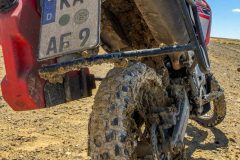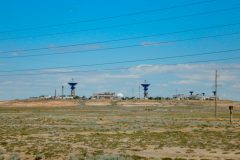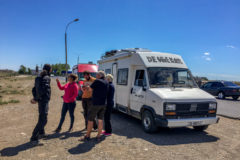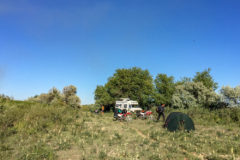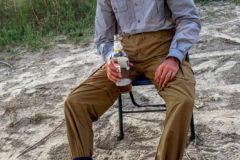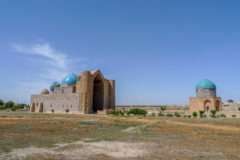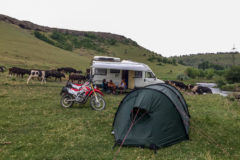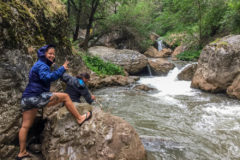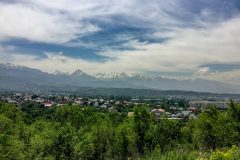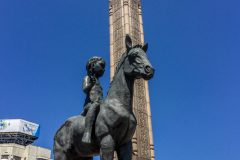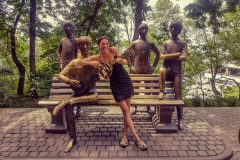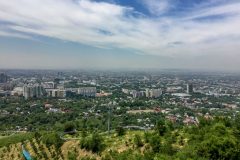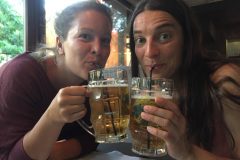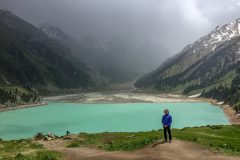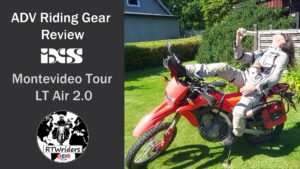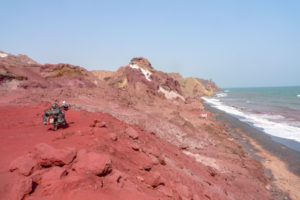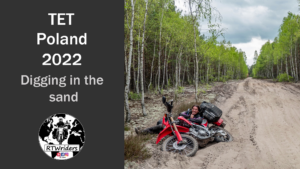The road between Astrakhan and the Kazakh border is good. Not far from the border you have to pay a small fee to cross a floating bridge, what is the highlight during this otherwise quite boring ride. At the border we are greeted with the familiar Russian friendliness. We are put on hold because they have to check with Moscow, if we are allowed to leave the country. So we are waiting again, just like when we entered the country. Two Germans with a MAN truck keep us company. Another hour later we are finally allowed to continue.
We ride towards the Kazakh side of the border and cross a bridge with a police post in the middle. There are two heavily armed border guards and we can already see from a distance. We are expecting to be welcomed as friendly as in Russia. Surprisingly they are only about 20 years old and very happy to see a few foreigners. They even fill out all the border documents for us and wish us a safe journey. At the customs everything goes very quickly. Miriam reaches the immigration both first. While she is still waiting for her documents (her mind drifted away), the official quickly grabs her hand, pulls it through the small opening into the house, introduces himself by name and wishes a friendly “Welcome to Kazakhstan”.
It happens quite similar to me and after a little chit-chat, we have already entered Kazakstan. We were definitely amazed for a moment, since we didn’t expected so much kindness after coming from Russia into Kazakhstan.
Shortly after the border the street turns into a battlefield. There is almost no tarmac anymore and the remaining pieces are potholed. Pot holes are caused by holes in the asphalt, where the wind has blown away the sand and dust underneath. Some of these holes are extremely deep and you could easily hide a small child in there. Everyone can probably imagine, how it would end, if you hit one of those with your front tire. Driving on this road is especially arduous for cars and trucks, so everyone tries to drive zigzag on the remaining tarmac pieces for the whole ~300 kilometers (~185 mi). Except for the first camels on our trip, there is not much to see on this route and the temperature is 39°C (102°F). Fortunately, the asphalt gets better shortly before Atyrau and we manage to reach Atyrau’s downtown before darkness. We find a nice hostel and decide to take a day off.
The next morning we are about to leave the hostel in short clothes to explore the city, when an icy wind hits us after we opened the hostel’s front door. What the heck has happened there? We look briefly at the weather report and the forecast promises 17°C (62°F) and “dust”. So we have a temperature drop of 22 degrees within one night and the precipitation forecast promises dust??
That’s why we decide to get changed again to explore the city. As we learn shortly afterwards, dust means sandstorm and the whole thing is really damn cold at 17°C. We walk a few kilometers through the city, but there isn’t really much to see in Atyrau. The wind blows like hell at the same time and our faces get an unpleasant sand peeling. So we are not really sad to return to our hostel some time later. The temperature won’t change for the next few days and there will be rain, too. For this reason we decide to ride the longer route via Oral to Aktobe. The direct road to Aktobe is almost impassable when it rains.
The landscape towards Oral is extremely monotonous and boring, but we have already known that before. It leads 500 kilometers (~310 mi) straight north, but the road isn’t as bad as two days ago at least. Every now and then there is a dead cow next to the street, what is basically the only variety for the whole route. Shortly before Oral we discover a small green area a few hundred meters off the main road and set up our night camp at this place. It is the first green area after hundreds of kilometers. Unfortunately, the mosquitoes are just as happy about it as we are. We have to spend most of the evening in the tent to avoid being eaten alive.
The next morning we drive the last kilometers towards Oral and finally turn eastwards. The weather is not only cold now, it is really rainy and windy, too. We have to wear down jackets under the rain clothes. A stupid wind also blows us almost off the road and the 500 kilometers to Aktobe are extremely exhausting.
Before we arrived in Kazakhstan, people warned us about the extreme heat. You should choose the routes carefully, because the heat is unbearable and you can easily die of thirst. However, we are on the verge of freezing to death and all we would have to do to get water, is to open our mouths and stretch them out towards the sky.
Shortly after Oral we behold the most motivating street sign in the world “Shymkent 2000 and something kilometers” (to Almaty it is additional 700 kilometers) – thanks to the Kazakh road authority! We briefly shop in Aktobe and then set up our tent again a few kilometers after Aktobe. Fortunately it stops to rain for a short time and after a full day of rain, we have a nice sunset at least.
After breakfast it starts raining cats and dogs again and we get completely soaked while packing our tent. We are looking forward to more than 600 kilometers to Aral. The landscape has now become a green steppe instead of a brown steppe, but that doesn’t make it much more exciting in the long run. At least the wind is coming diagonally from behind, so we hardly need any petrol and it is much more comfortable to ride. Refueling is finally fun, too. The average petrol price is around 35 €-cents per litre.
When we arrive in Aral in the evening, we are quite exhausted and are happy to find a nice hostel immediately. Aral was once a busy fishing village, until the Aral Sea nearly completely disappeared due to an environmental mess that has no equal. Massive irrigation of cotton plantations in Uzbekistan and Kazakhstan caused the water volume to decrease by 90 percent and the salinity has quadrupled in some parts. In addition, the gigantic amounts of pesticides they had been using in the past, are spread all over the world due to this dehydration. In short, the area is not only deserted, but also extremely contaminated. The whole thing is comparable to the catastrophe of Chernobyl. However nobody really cares/knows about it, because it is situated in the middle of nowhere and the distance to the western countries is too far. If you are interested, you can read the whole story more detailed in the Internet.
We decide to set off towards Baikonur the next day. After a few kilometers I discover a beautiful, dry salt surface and want to ride my motorcycle to the middle for some nice photos. However, I get completely stuck in salty mud after 20 meters. We need 15 minutes of hard struggle and removed luggage to bring my bike back to a steady subsoil – of course it looks like hell.
After the collapse of the USSR, Baikonur was owned by Kazakhstan and leased to Russia. The cosmodrome is the largest rocket launch site in the world and extends to an enormous scale. The majority of the small town of Baikonur can’t be seen at all, but supposedly you can see all rocket launches from all platforms. Unfortunately you are not allowed to enter the centre of Baikonur and the nearby launch site without permission. The approval has to be requested months in advance and you also have to dig deep into your pockets. We just join the queue and try to enter “by accident”. It is no wonder that we get rejected and have to turn around. Too bad – that would have been very interesting.
On a little lay-by we meet other tourists with camper vans, that have recently tried to enter as well – two Germans and a Swiss couple, Andreas and Andrea. Due to the letdown of the denied admission to the rocket launch site, we decide to buy a few beers and go camping with the swiss couple. Andreas is a Swabian Swiss with Russian descent and to my delight a “verified” beer drinker. He also speaks Russian fluently. Andrea is a real Swiss woman, she cooks very tasty food and wants to become a “verfied” beer drinker at some point – but she still has to practice a bit. We get along so well, that we will finally spend the next 4 weeks together.
After a peaceful night at a nice river, we continue towards Turkistan. We drive a full day without any special occurrences. The landscape has now become a desert, but it is still not really interesting. The next day we reach Turkistan and visit the mausoleum, the most important pilgrimage site in Kazakhstan. This area has already a strong taste of Uzbekistan. Afterwards we drive on, pass Shymkent and find a great place to spend the night at a green hilly area. The real highlight is the fact, that we can see mountains again. We have reached the northern part of the highest mountain range in the world after over 3000 kilometers of wasteland.
After breakfast the next day we only drive a few kilometers to search a cave, which we will never find. Instead of that we end up in a very beautiful canyon, where we decide to stay one night and continue to Almaty, the former capital of Kazakhstan, the next day. After another overnight stay we finally reach Almaty. The most boring route of our entire trip is over. From now on the landscape is interesting again. We stay in one of the coolest hostels, we have ever been – the European Backpacker Hostel. Andrea and Andreas can still sleep in their camper and we are allowed to pitch our tent in the garden. The hostel is nice, the location is good, the owner is very relaxed and helpful. The guests spend lots of time together, exchange ideas, eat and go out in the evenings.
Almaty is very big, but also very green. The city is modern and not very cheap either. In the background you can always see the high mountains as long as they are not covered by rain clouds. However it seems to rain quite often. Motorcycle riders in this region are exotic in general. People start honking and waving quite often. The big trucks honk you almost off the road to greet you and at traffic lights, people ask for your home country and if you have really driven the entire route by motorcycle.
Tobi’s bike needs a new chain and both motorcycles need new rear tires. Almaty is the best place for this in the whole area, but it is still not easy to find motorcycle parts here. We are lucky with our small bikes and can buy the required parts quite easily. Almaty is a good place to relax for a while, so we take our time to explore the city and ride to the Big Almaty Lake. After a few days we finally head east to the Altyn Emel National Park.
